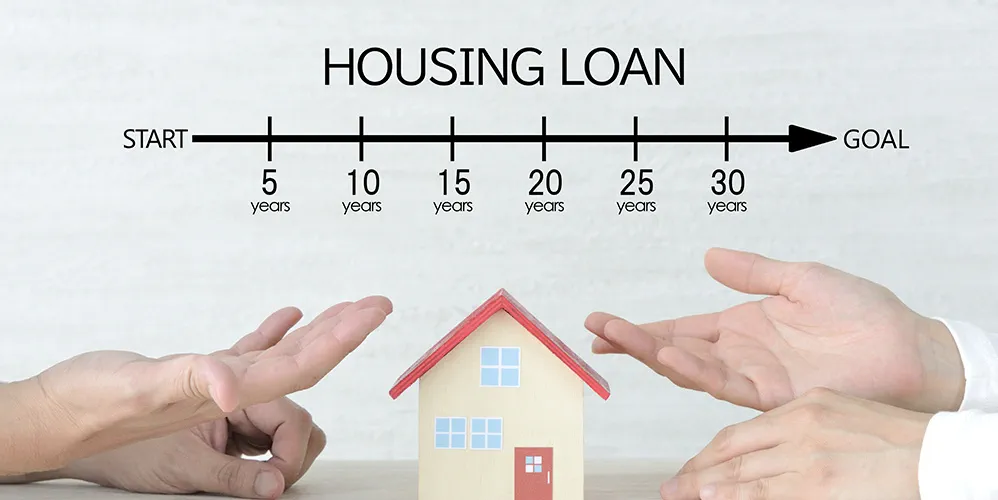Table of Content
- What is Home Loan Tenure?
- Why is Choosing the Right Tenure Important?
- 10, 20, or 30-Year Tenure: A Comparative Analysis
- Factors to Consider When Choosing Home Loan Tenure
- The Role of Prepayment in Optimizing Tenure
- Strategies to Choose the Best Tenure
- Short-Term vs. Long-Term Home Loan Tenures
- Conclusion
Buying a home is a significant milestone and one of the largest financial commitments an individual makes in their lifetime. With property prices constantly rising, most people turn to home loans to bridge the financial gap. While applying for a home loan is a relatively straightforward process, choosing the right tenure can be daunting. Your home loan tenure directly impacts your monthly EMIs, total interest paid, and long-term financial health. This article explores the nuances of home loan tenures and offers insights to help you make the best decision based on your financial circumstances.
What is Home Loan Tenure?
Home loan tenure is the duration over which a borrower agrees to repay their loan, including both the principal and interest amounts. Lenders typically offer tenures ranging from 5 to 30 years. The chosen tenure determines your monthly EMI amount and the total cost of borrowing.
For instance, opting for a shorter tenure results in higher EMIs but significantly reduces the total interest paid. Conversely, a longer tenure lowers the EMI but increases the cumulative interest over time. Striking the right balance between affordability and total cost is key to choosing an ideal home loan tenure.
Why is Choosing the Right Tenure Important?
Selecting an appropriate tenure ensures that you can comfortably manage your EMIs without compromising your lifestyle or financial goals. The right tenure provides:
- Affordability: Ensures EMIs fit within your monthly budget.
- Cost Efficiency: Helps minimize the overall interest paid on the loan.
- Flexibility: Allows you to align loan repayment with your long-term financial plans.
10, 20, or 30-Year Tenure: A Comparative Analysis
10-Year Tenure
Benefits:
- Faster loan closure and reduced debt burden.
- Lowest total interest paid, saving significantly over the loan duration.
- Ideal for individuals with high disposable incomes.
Drawbacks:
- Higher EMIs can strain monthly finances.
- Requires robust financial stability to manage other expenses alongside EMIs.
20-Year Tenure
Benefits:
- Balanced EMI amount and interest costs.
- Suitable for mid-income earners seeking manageable repayment terms.
- Offers moderate savings compared to a 30-year tenure.
Drawbacks:
- Higher overall interest compared to a 10-year tenure.
- May require disciplined financial planning to avoid long-term debt pressure.
30-Year Tenure
Benefits:
- Lowest EMI amounts, making it easier to manage monthly cash flow.
- Provides flexibility for younger borrowers with lower initial incomes.
- Allows for higher loan eligibility due to extended repayment capacity.
Drawbacks:
- Maximum interest paid over the loan period.
- Prolonged debt obligations may limit financial flexibility for future investments.
Also Read: Property Insurance for Home Loan: Why It’s Essential for Homeowners
Factors to Consider When Choosing Home Loan Tenure
1. Age of the Borrower
Age is a critical factor in determining loan tenure. Lenders typically require borrowers to repay their loans before retirement.
- Younger applicants can benefit from longer tenures, enjoying lower EMIs.
- Older borrowers may need shorter tenures, aligning with their retirement plans.
For instance, a 30-year-old applicant can opt for a 30-year tenure, while a 50-year-old applicant may have to choose a tenure of 10–15 years.
2. Loan Amount
The loan amount significantly influences tenure selection. Larger loan amounts often necessitate longer tenures to keep EMIs manageable. However, choosing a shorter tenure for smaller loans can save on interest costs.
3. Monthly Income and Expenses
Ideally, your EMI should not exceed 35% of your gross monthly income. A thorough assessment of your income, expenses, and financial obligations can help determine whether a short or long tenure is more suitable.
4. Existing Financial Obligations
Borrowers with multiple loans or debts should carefully evaluate their repayment capacity. Opting for a longer tenure with lower EMIs can ease financial pressure while managing concurrent financial responsibilities.
5. Interest Rates
Fluctuations in interest rates can impact your repayment strategy. Fixed-rate loans provide consistency, while floating-rate loans offer flexibility to make prepayments and reduce tenure during favorable economic conditions.
6. Prepayment Options
Prepaying part of your home loan can significantly reduce both the tenure and total interest paid. Borrowers should review their lender’s prepayment policies to make informed decisions.
The Role of Prepayment in Optimizing Tenure
Prepaying a home loan reduces the principal amount, which in turn lowers the interest payable. Key benefits include:
- Reduced Loan Tenure: Allows borrowers to clear their loans faster.
- Lower Total Interest: Saves money by decreasing the interest-bearing principal.
- Increased Financial Flexibility: Frees up resources for other investments.
Strategies to Choose the Best Tenure
- Assess Your Financial Health: Consider your income, expenses, and future goals.
- Prioritize Savings: If possible, opt for a shorter tenure to save on interest costs.
- Strike a Balance: Choose a tenure that aligns with your lifestyle, ensuring manageable EMIs and minimal stress.
Short-Term vs. Long-Term Home Loan Tenures
Short-Term Loans (5–10 Years):
- Suitable for borrowers with high incomes and low existing debts.
- Offers faster repayment and greater savings on interest.
Long-Term Loans (20–30 Years):
- Ideal for younger borrowers or those with limited income.
- Provides financial flexibility through lower EMIs but increases the total interest paid.
Conclusion
There is no universal answer to what constitutes the ideal home loan tenure. The decision depends on individual preferences, financial status, and long-term goals. While shorter tenures save on interest costs, longer tenures offer flexibility with manageable EMIs.
Striking a balance between affordability and cost-efficiency is crucial. By carefully evaluating your age, income, expenses, and future aspirations, you can select a home loan tenure that aligns with your needs. Remember, proper financial planning and prudent decision-making are key to ensuring a smooth and stress-free home loan repayment journey.
Choose wisely and enjoy the satisfaction of turning your dream home into a reality!



_1758715186.webp)



_1767164061.webp)


Ans 1. Home loan tenure is the duration agreed upon for repaying the loan, including both the principal and interest amounts. It typically ranges from 5 to 30 years, influencing the EMI amount and the total cost of borrowing.
Ans 2. The right tenure ensures financial comfort by balancing EMI affordability and minimizing total interest costs. It helps borrowers align repayment with their financial goals and avoid undue strain on their budget.
Ans 3. A 10-year tenure allows for faster loan repayment, significantly reducing the total interest paid. However, the EMIs are higher, making it suitable for borrowers with strong financial stability and disposable income.
Ans 4. A 20-year tenure strikes a middle ground with manageable EMIs and moderate interest costs. It is ideal for mid-income earners who want a balance between affordability and savings.
Ans 5. A 30-year tenure offers the lowest EMIs, providing flexibility for younger borrowers or those with limited initial income. While it increases the total interest paid, it eases monthly cash flow and enhances loan eligibility.
Ans 6. Key factors include the borrower’s age, loan amount, monthly income, existing financial obligations, interest rates, and prepayment options. These elements help determine the most suitable tenure based on financial capacity and goals.
Ans 7. Younger borrowers can opt for longer tenures, benefiting from lower EMIs and extended repayment periods. Older borrowers nearing retirement may need shorter tenures to complete repayment within their working years.
Ans 8. Prepayment reduces the loan's principal amount, lowering interest costs and shortening the tenure. It provides financial flexibility, allowing borrowers to pay off their loans faster while saving on interest.
Ans 9. Shorter tenures save on interest but come with higher EMIs, requiring robust financial health. Borrowers must assess their income stability and ability to manage other expenses before opting for a shorter tenure.
Ans 10. Fixed-rate loans offer consistent EMIs, aiding in long-term planning. Floating-rate loans provide flexibility for prepayments, allowing borrowers to adjust tenure based on favorable interest rate changes.